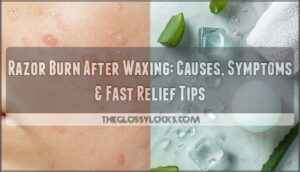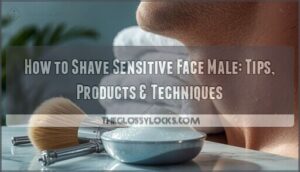This site is supported by our readers. We may earn a commission, at no cost to you, if you purchase through links.
 Your legs endure miles of movement every day, yet they’re often the last place to get proper skincare attention. Dead skin cells pile up faster on legs than almost anywhere else on your body—friction from clothing, dry air, and constant motion all accelerate buildup.
Your legs endure miles of movement every day, yet they’re often the last place to get proper skincare attention. Dead skin cells pile up faster on legs than almost anywhere else on your body—friction from clothing, dry air, and constant motion all accelerate buildup.
Natural exfoliation strips away this dull layer without the harsh chemicals found in commercial products, revealing smoother skin that actually absorbs the moisturizers you apply.
The best part? Effective natural scrubs live right in your kitchen, and they work without irritating sensitive skin or draining your wallet. Learning the right techniques protects your skin barrier while delivering the glow and softness you’re after.
Table Of Contents
Key Takeaways
- Natural exfoliation removes dead skin buildup on legs more effectively than harsh chemicals, using kitchen staples like brown sugar, coffee grounds, and sea salt to reveal smoother skin that absorbs moisturizers up to 40% more effectively.
- Your skin type determines exfoliation frequency—normal skin tolerates 2-3 times weekly, while sensitive or dry skin requires gentler treatment once weekly to avoid barrier damage, redness, and irritation.
- Skipping regular exfoliation leads to visible dullness, rough texture, clogged pores, and more pronounced cellulite as dead cells accumulate and block moisture absorption.
- Proper technique matters: always prep skin with warm water to open pores, use gentle circular motions, and apply moisturizer within three minutes post-exfoliation to lock in hydration and prevent irritation.
Why Exfoliate Legs Naturally?
Your legs deserve more than a quick rinse—they need real care to stay smooth and healthy.
Natural exfoliation clears away dead cells without harsh chemicals, giving your skin room to breathe and glow. Here’s what makes it worth your time.
Key Benefits for Skin Health
Exfoliation ignites skin renewal by clearing dead cells and triggering fresh cell regeneration. You’ll notice improved texture and enhanced glow within just weeks—studies show up to 35% softer skin after consistent routines.
Exfoliation clears dead skin cells, revealing softer, brighter legs with up to 35% improved texture in weeks
Natural ingredients in DIY exfoliation recipes boost cell renewal while supporting better hydration, allowing moisturizers to absorb up to 40% more effectively. Regular exfoliation strengthens your skin health from the outside in.
Effective hydration methods, such as gentle skin care, can maximize the exfoliation process for peak results.
How Exfoliation Improves Skin Texture
When you buff away that rough, dull outer layer, you’re making room for smoother, softer skin that actually reflects light instead of scattering it. Exfoliation techniques using natural ingredients accelerate cell renewal and texture enhancement—here’s what you reveal:
- Skin smoothing that transforms rough patches into touchable softness
- Glow boosting that creates visible radiance restoration within days
- Even tone as exfoliation fades dark spots and discoloration
- Deeper absorption so your moisturizers actually work
Risks of Skipping Regular Exfoliation
Skip your exfoliation routine long enough, and your legs will show you exactly what you’ve been missing—and not in a good way. Dead skin buildup creates a visible barrier that blocks moisture and traps dull, flaky cells on the surface.
Here’s what neglecting exfoliating legs safely does to your skin:
| What Happens | Why It Matters |
|---|---|
| Skin dullness spreads across your legs | Dead skin cells scatter light instead of reflecting it, stealing your natural glow |
| Rough texture becomes impossible to ignore | Buildup creates uneven patches that no moisturizer can smooth |
| Cellulite formation appears more pronounced | Poor circulation and trapped fluids make dimpling more visible |
Without regular exfoliation, even sensitive skin suffers from clogged pores and skin irritation as oils and debris accumulate beneath that stubborn layer.
Choosing The Right Exfoliation Method
Not all legs are the same, and neither are exfoliation methods. Your skin type and sensitivity level will guide you toward the techniques that work best without causing irritation.
Let’s break down how to match your skin’s needs with the right approach.
Identifying Your Skin Type
Your skin type isn’t a mystery—it’s written all over your legs, waiting for you to read the signs. Normal skin feels balanced, without flaking or excess sensitivity. Dry skin shows up as rough patches or itchy spots that need extra attention. Sensitive skin reacts quickly—stinging or burning after exfoliation tells you to tread carefully.
Type determination guides which exfoliation method works best for you.
Manual Vs. Chemical Exfoliation
Physical exfoliation relies on abrasive substances—brushes, scrubs, or salt—to manually buff away dead cells. It works fast, smoothing texture immediately, but coarse particles risk microtears.
Chemical exfoliation uses acids (AHAs for dry skin, BHAs for oily) or enzymes to dissolve cell bonds gently. Research shows chemical peels deliver even tone with less irritation than harsh manual scrubbing.
Match exfoliant types to your skin sensitivity: physical suits thicker skin, chemical protects reactive types. Proper exfoliation frequency—weekly for most—prevents barrier damage while safely exfoliating legs. Understanding the benefits of skin care routines is essential for maintaining healthy skin.
Best Tools for Exfoliating Legs
Choosing the right tool transforms exfoliation from a guessing game into a targeted ritual that respects your skin’s unique needs. Exfoliating brushes and loofahs offer firm, mechanical friction—ideal for thicker skin that tolerates pressure. Leg sponges deliver gentler buffing, while dry brushing boosts circulation before you even step into the shower.
Sugar scrubs combine manual exfoliation with hydration, and ultrasonic cleansers provide vibration-based precision without abrasion.
For deeper results, microdermabrasion systems polish away stubborn roughness, though they demand caution on sensitive zones.
Safe and Effective DIY Exfoliant Recipes
Making your own leg scrubs at home gives you full control over ingredients and lets you skip unnecessary additives.
You’ll find these recipes simple to whip up with pantry staples, and they work just as effectively as store-bought options.
Each formula targets specific skin concerns while remaining gentle enough for regular use.
Brown Sugar and Honey Scrub
Brown sugar and honey make one of the gentlest—and most affordable—scrubs you can whip up at home. Honey’s antimicrobial properties help protect your skin while brown sugar‘s fine granules buff away dead cells without scratching. This natural ingredients combo delivers gentle exfoliation that won’t strip moisture.
Why it works:
- Brown sugar dissolves gradually, reducing irritation risk
- Honey nourishes and locks in hydration during exfoliation
- You control the consistency for tailored skin nourishment
Coffee Scrub for Cellulite
Coffee grounds don’t just wake you up in the morning—they can temporarily smooth the look of dimpled skin on your legs. The caffeine in coffee scrubs helps tighten skin temporarily, making cellulite less noticeable.
Mix used grounds with coconut oil for natural exfoliation that buffs away dead cells while stimulating circulation. This DIY remedy offers leg toning benefits without harsh chemicals.
Sea Salt and Essential Oil Scrub
Sea salt crystals act like tiny power tools for your skin, sloughing away rough patches while essential oils deliver moisture and a spa-like scent that transforms leg care into a ritual you’ll actually look forward to. This scrub recipe combines salt benefits with skin nourishment that actually works.
Here’s how to create your sea salt scrub:
- Mix ½ cup sea salt with ¼ cup carrier oil (coconut or jojoba work beautifully)
- Add 10 drops of your favorite essential oil—lavender calms, peppermint energizes
- Stir until you get a thick paste that won’t slide off your legs
- Store in a sealed jar and use within two weeks for freshest results
This natural exfoliant delivers smooth skin without the chemical lineup you can’t pronounce.
Tips for Customizing Homemade Scrubs
Your homemade scrub isn’t locked into one recipe—you can tweak the texture, scent, and skin benefits by swapping ingredients based on what your legs actually need.
For sensitive skin types, use fine-grain brown sugar instead of coarse sea salt. Oily skin responds well to coffee grounds mixed with grapefruit oil, while dry skin craves coconut oil bases.
Adjust exfoliant textures by changing granule size—smaller particles work gently, larger ones tackle stubborn rough patches with more intensity.
Step-by-Step Guide to Exfoliating Legs
Exfoliating your legs the right way makes all the difference between glowing skin and unnecessary irritation. The process isn’t complicated, but getting each step right protects your skin while delivering real results.
Here’s how to exfoliate safely and effectively from start to finish.
Prepping Your Skin for Exfoliation
Before you reach for any scrub, take a moment to soften and warm your skin—it makes all the difference in how well exfoliation works. Start with a warm shower or bath to open pores and loosen dead cells.
Gently cleanse with a pH-balanced wash to remove oils and debris without stripping your skin barrier. This prep step is critical for all skin types, especially sensitive or dry skin—it helps exfoliation feel smoother and work better.
How to Apply Your Scrub
Once your skin is prepped and warm, scoop a small amount of scrub into your palm and start working it onto your legs in gentle, circular motions. Apply slight pressure—enough to feel the exfoliant working, but not so much that it hurts.
Focus on rough patches like knees and ankles, where dead skin builds up fastest. These manual exfoliation techniques help boost circulation while buffing away dull cells for smoother results.
Avoiding Over-Exfoliation and Irritation
Going too hard or too often can backfire—your skin will tell you when you’ve crossed the line. Watch for redness, peeling, or stinging—classic irritation signs that mean you’ve overdone it. If that happens, stop exfoliating immediately and focus on skin barrier repair with gentle techniques and fragrance-free moisturizers.
Sensitive skin care requires lighter pressure and less frequent sessions to keep exfoliation limits in check while exfoliating legs safely.
Aftercare and Moisturizing Essentials
After exfoliation, locking in moisture is key to keeping your legs soft and preventing that tight, uncomfortable feeling. Apply moisturizer within three minutes—your skin absorbs it better when slightly damp.
Choose products that match your skin’s needs:
- Sensitive skin: Fragrance-free formulas like CeraVe or La Roche-Posay
- Dry skin: Rich creams with natural oils
- Normal skin: Lightweight lotions work well
- Extra hydration: Add a few drops of oil before moisturizing
Gentle cleansing and proper post-exfoliation care make all the difference.
How Often Should You Exfoliate Your Legs?
Getting the timing right makes all the difference between healthy, glowing legs and irritated skin that’s had enough. Your skin type dictates how often you should reach for that scrub, and your body will send clear signals if you’re overdoing it.
Let’s break down the right frequency for your needs and how to make exfoliation a natural part of your routine.
Exfoliation Frequency by Skin Type
The right exfoliation frequency depends entirely on your skin type—it’s not one-size-fits-all. Normal skin tolerates exfoliation schedules of 2–3 times weekly, while dry or sensitive skin needs gentler techniques just once a week or even biweekly.
Oily and acne-prone skin manages more frequent physical exfoliation or chemical exfoliation with BHAs up to 3–4 times weekly. Combination skin benefits from tailored routines targeting specific areas.
Mature skin requires reduced frequency—once or twice weekly—to avoid irritation. Proper skin type analysis guarantees safe, effective exfoliation frequency and safety.
Signs You’re Over-Exfoliating
If you notice redness, irritation, or persistent flaking, you’ve likely crossed the line from exfoliating to damaging. Other red flags include burning, stinging sensations, or increased skin sensitivity—your body’s way of waving a white flag.
When these signs show up, dial back your exfoliation frequency immediately and switch to gentler techniques. Give your skin time to heal before you jump back in.
Building Exfoliation Into Your Routine
The secret to consistent results isn’t adding more steps—it’s weaving exfoliation seamlessly into what you already do. Pair it with your shower routine twice weekly, store your DIY scrubs within arm’s reach, and let skin renewal happen naturally.
Consistent exfoliation schedules beat sporadic bursts every time, keeping your leg care routine simple and effective.
Frequently Asked Questions (FAQs)
What ingredients work best for sensitive skin?
For sensitive skin, choose finely ground brown sugar over coarse sea salt.
Add natural oils like coconut or jojoba, plus calming agents like honey or oatmeal.
Avoid essential oils that trigger skin irritation.
How long do homemade scrubs stay fresh?
Most homemade scrubs stay fresh for one to two weeks when stored properly in an airtight container in the refrigerator.
Shelf life depends on your ingredients—oil-based scrubs last longer than those with fresh produce or dairy.
Can you exfoliate legs before or after shaving?
You can exfoliate before shaving to remove dead skin cells and prep your skin, reducing razor burn. However, exfoliating after lets your razor glide smoothly first, then clears away any remaining buildup—just watch for skin sensitivity and adjust your exfoliation frequency accordingly.
Whats the difference between wet and dry exfoliation?
Dry brushing uses stiff bristles on bare skin before showering, while wet exfoliants—like scrubs or chemical exfoliation—work on damp skin with water.
Both physical exfoliant techniques remove dead cells effectively when you apply gentle techniques consistently.
Are there natural alternatives to chemical exfoliants?
You don’t need chemical exfoliants when natural alternatives work beautifully. DIY exfoliation recipes using brown sugar, coffee grounds, or sea salt provide effective mechanical exfoliation, while botanical peels and herbal remedies offer gentler options for sensitive skin.
Conclusion
An ounce of prevention is worth a pound of cure"—and with natural ways to exfoliate legs, you’re preventing buildup before it becomes a problem. Your kitchen holds everything you need: sugar, coffee, honey, and salt transform dull skin without harsh chemicals.
Listen to your skin’s signals, adjust your frequency accordingly, and always follow with deep moisture. Smooth, healthy legs don’t require expensive products—just consistent care with ingredients that respect your skin’s natural barrier.










